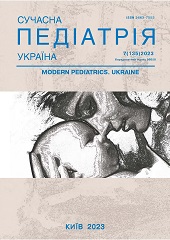Tonsillectomy in children: therapeutic possibilities in optimising the results of surgical intervention
DOI:
https://doi.org/10.15574/SP.2023.135.7Keywords:
children, chronic tonsillitis, tonsillectomy, TonsilotrenAbstract
Tonsillectomy is one of the most common surgical interventions. The search for effective medical measures to optimize the course of regeneration processes in a postoperative wound is urgent.
Purpose - to evaluate the effect of the complex homeopathic preparation Tonsilotren on the reparative processes of the postoperative period in children who underwent tonsillectomy.
Materials and methods. The test group of 70 patients with chronic tonsillitis and 30 patients of the control group aged from 6 to 17 years were under observed and compared. All patients in the test group received Tonsilotren 7 days before surgery and for 2 weeks after surgical tonsillectomy. The examination of the ENT doctor was carried out during 5 visits: 1 visit before the operation, 2-5 visits - corresponded to the period from 1 to 14 days of the postoperative period. The results of observation were evaluated according to the following indicators: hyperemia of the mucous membrane of the faucial pillars, swelling of the mucous membrane of the faucial pillars, fibrinous pellicle in the postoperative wound, epithelization of the postoperative wound, bleeding from the postoperative wound, blood clots in the postoperative wound, scarring of the faucial pillars, pain intensity to VAS scale during swallowing and eating solid food, side effects, tolerability of the Tonsilotren medicine, complications of the disease, the need and duration of use of analgesics.
Results. Prescribing of the Tonsilotren medicine to patients with chronic tonsillitis during and after surgical treatment (tonsillectomy) significantly increases the effectiveness of the treatment, namely: it helps to reduce the intensity of pain during swallowing and eating solid food, hyperemia and swelling of the mucous membrane of the faucial pillars, acceleration of epithelization of the postoperative wound, reduces scaring of faucial pillars (p<0.05). Epithelization of the postoperative wound with an area of more than 75% of its surface was observed in 24 (34.3%) patients on the 10th day and in 68 (97.1%) patients on the 14th day after the operation in the test group, while this indicator occurred in the control group only in 13 (43.3%) children on the 14th day after surgery. During observation, no side effects of the Tonsilotren medicine and adverse events were detected, which confirms the safety of its use.
Conclusions. Course use of the Tonsilotren medicine in children in preparation for tonsillectomy and in the postoperative period demonstrates better effectiveness compared to standard treatment in terms of indicators of postoperative wound healing, rates of epithelization, absence of scarring and blood clots, and less pronounced pain syndrome.
The research was carried out in accordance with the principles of the Helsinki Declaration. The study protocol was approved by the Local Ethics Committee of the participating institution. The informed consent of the patient was obtained for conducting the studies.No conflict of interests was declared by the authors.
References
Baugh RF, Archer SM, Mitchell RB et al. (2011). Clinical practice guideline: tonsillectomy in children. Otolaryngol. Head Neck Surg. 144 (S1): S1-30. doi: 10.1177/0194599810389949. URL: https://journals.sagepub.com/doi/pdf/10.1177/0194599810389949.
Hall MJ, Schwartzman A, Zhang J, Liu X. (2010). Ambulatory surgery data from hospitals and ambulatory surgery centers: United States. Nat. Health Stat. Report. 2017; 102: 1-15.
Holubchykov MV, Kosakovskyi AL, Rudenko NH, Rudenko OV. (2016). Otolarynholohichna dopomoha ditiam 0-17 rokiv vkliuchno, shcho perebuvaiut pid nahliadom u zakladakh okhorony zdorovia sfery upravlinnia MOZ Ukraïny za 2015 rik. Statystychno-analitychnyy̆ dovidnyk. Kyïv: 125.
Kosakovskyy̆ AL, Levytska SA. (2021). Tonzylit (khronichnyy̆, rekurentnyy̆, retsydyvuiuchyy̆): prosto pro skladne. Monohrafiia. Vinnytsia: 188.
Kryuchko TA, Specht TV et al. (2010). Results of clinical studies on the use of Tonsilotren in children with chronic tonsillitis. Children's doctor. 5: 54-58.
Kvestad E, Kvaerner KJ, Roysamb E, Tambs K, Harris JR, Magnus P. (2005, May). Heritability of recurrent tonsillitis. Arch. Otolaryngol. Head Neck Surg. 131(5): 383-387. https://doi.org/10.1001/archotol.131.5.383; PMid:15897415
Mitchell RB, Archer SM, Ishman SL et al. (2019, Feb). Clinical Practice Guideline: Tonsillectomy in Children (Update) - Executive Summary. Otolaryngol. Head Neck Surg. 160 (2): 187-205. https://doi.org/10.1177/0194599818807917; PMid:30921525
Moroco AE, Saadi RA, Wilson MN. (2020, Apr). Post-tonsillectomy respiratory complications in children with sleep disordered breathing. Int. J. Pediatr. Otorhinolaryngol. 131: 109852. https://doi.org/10.1016/j.ijporl.2019.109852; PMid:31901486
Ostermann T, Park AL, De Jaegere S et al. (2021, Sep 19). Cost-effectiveness analysis for SilAtro-5-90 adjuvant treatment in the management of recurrent tonsillitis, compared with usual care only. Cost. Eff. Resour. Alloc. 19(1): 60. https://doi.org/10.1186/s12962-021-00313-4; PMid:34538271 PMCid:PMC8451093
Palm J, Kishchuk VV, Ulied A et al. (2017). Effectiveness of an add-on treatment with the homeopathic medication SilAtro-5-90 in recurrent tonsillitis: An international, pragmatic, randomized, controlled clinical trial. Complement. Ther. Clin. Pract. 28: 181-191. https://doi.org/10.1016/j.ctcp.2017.05.005; PMid:28779928
Soldatov IB. (1994). Guide to otorhinolaryngology. Medicine: 608.
Zabolotko VM, Kosakovskyi AL, Rudenko NH, Rudenko OV. (2017). Otolarynholohichna dopomoha ditiam 0-17 rokiv vkliuchno, shcho perebuvaiut pid nahliadom u zakladakh okhorony zdorovia sfery upravlinnia MOZ Ukraïny za 2016 rik. Statystychno-analitychnyi dovidnyk. Kyïv: 156.
Zabolotnyi DY, Melnykov OF, Kosakovskyi AL, Zabolotnaya DD, Bredun AIu. (2016). Patohenetycheskye osnovy dyahnostyky y lechenyia khronycheskykh tonzyllytov y adenoydytov u detey̆ y vzroslykh. Zhurnal vushnykh, nosovykh i horlovykh khvorob. 3: 54-55.
Downloads
Published
Issue
Section
License
Copyright (c) 2023 Modern pediatrics. Ukraine

This work is licensed under a Creative Commons Attribution-NonCommercial 4.0 International License.
The policy of the Journal “MODERN PEDIATRICS. UKRAINE” is compatible with the vast majority of funders' of open access and self-archiving policies. The journal provides immediate open access route being convinced that everyone – not only scientists - can benefit from research results, and publishes articles exclusively under open access distribution, with a Creative Commons Attribution-Noncommercial 4.0 international license (СС BY-NC).
Authors transfer the copyright to the Journal “MODERN PEDIATRICS. UKRAINE” when the manuscript is accepted for publication. Authors declare that this manuscript has not been published nor is under simultaneous consideration for publication elsewhere. After publication, the articles become freely available on-line to the public.
Readers have the right to use, distribute, and reproduce articles in any medium, provided the articles and the journal are properly cited.
The use of published materials for commercial purposes is strongly prohibited.

